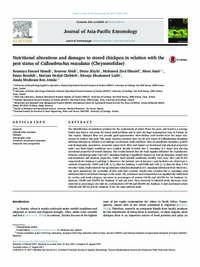Nutritional alterations and damages to stored chickpea in relation with the pest status of Callosobruchus maculatus (Chrysomelidae)

Authors:
The identification of substitute products for the replacement of wheat flours for paste and bread is a strategy which may help to overcome the wheat yield problems and to meet the huge consumption rates in Tunisia. In this respect, chickpea flour can provide good opportunities. Nevertheless, seed beetles were the major constraints to achieve this goal. This paper presents extensive data on the pest status of Callosobruchus maculatus infesting chickpea in relation to its damage on chickpea seeds and flour. Data on population dynamics, growth and demographic parameters, economic injury level (EIL) and impact on functional and physical properties under two food supply conditions were studied. Results revealed that C. maculatus is a major pest altering nutritional properties of stored chickpea. Our results showed that the food supplies influence the reproductive behavior and demographic traits of C. maculatus leading to significant impacts on seed germination, weight loss and functional and physical properties. Under food optimal conditions, fertility rates were 38.1 and 47.2% respectively for Amdoun 1 and Beja 1. Moreover, the intrinsic rate of increase r and the finite rate of increase λ reached, respectively, 0.057 and 1.06 ♀/♀/days for Amdoun 1 and 0.048 and 1.05 ♀/♀/days for Beja 1. On the other hand, results showed that germination reduction depended on C. maculatusinfestation level. Moreover, this work pointed out the variability of EILs with host varieties. Results also revealed that C. maculatus seed infestation led to nutritional changes in the seeds. The proximate seed composition was significantly influenced by variety and seeds category. Increases in percentages of protein (33.05 and 22.53% for 53 Amdoun 1), moisture (10.80 and 10.67% for Amdoun 1) and ash have been observed in infested seeds; decreases were observed in percentages of crude fat, carbohydrates (47.96 and 58.69% for Amdoun 1) and nutritional values (355.90 and 367.51 kcal for Amdoun 1) for the same infested seeds.
